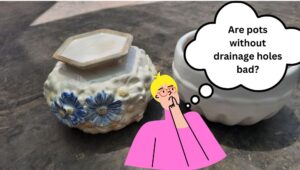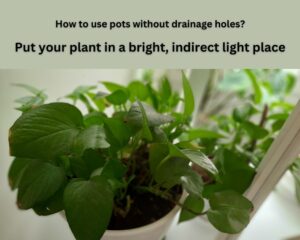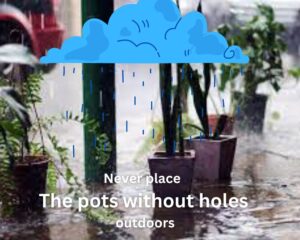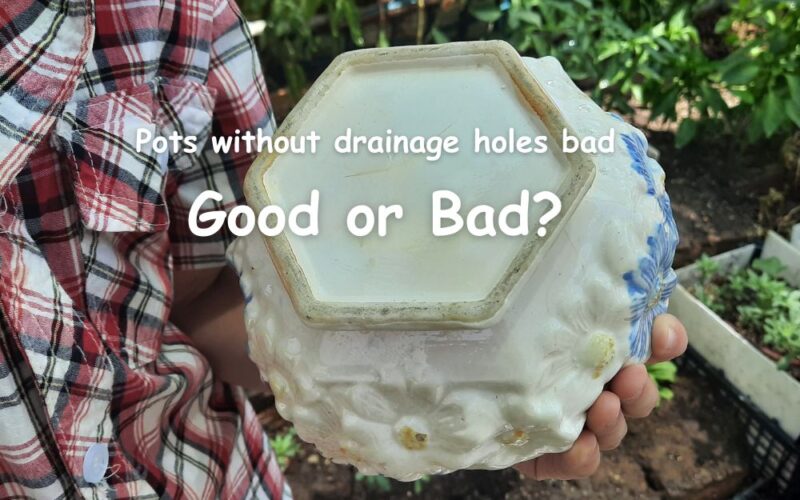If drainage is critical for the healthy growth of my plant, are pots without drainage holes bad? Join me in this article to tell you all things you should know.
In previous articles, I talked with you about the importance of drainage in planting and showed you why plants need a drainage hole. but there are a lot of pots in gardening centres that have no holes!
Although I told you “Why do they sell pots without drainage holes?” in my last post, people still ask me:
- Are pots without drainage holes bad?
- Can I use pots without drainage holes?
- What to do if the pot doesn’t have a drainage hole?

Hence, in this article, I want to show you pots without drainage holes are not only bad but can be good if you follow the below tips. If you are interested in knowing more about the advantages of planting in cachepots, read “Why do some plant pots not have holes?”
Pots without drainage holes are good if:
The most important consideration about planting in cachepots is drainage problems. In this part, I want to tell you planting in this kind of plant pot is not bad if you follow the tips mentioned in the following. I will show you how to make drainage in pots without holes. So, keep reading.
➡ You can hear the audio version of this article below:
How to plant in pots without drainage holes
In this part, I will tell you pro tips that help you plant in pots without drainage holes.
1- Use the method of pot within the pot (double potting)
It is a perfect way that let you gain the benefits of a cachepot and drainage together, indeed you sign your pot as a cachepot. It is very easy. Follow the below tips to gain a perfect result (take note of the following infographic):

- you need two pots: a planter with a hole and another without holes. The container that has a drainage hole must be smaller than the cachepot.
- Plant your house plant into the smaller planter (with holes) and put it in the bigger pot (without holes).
- For watering, remove the smaller pot from the larger decorative cachepot and let the extra water drain from it. then replace the smaller pot with a cachepot.
- If you want to water your plant without removing it from its decorative pot, you must avoid over-watering because the extra water will accumulate in the cachepot. it is like you place your pot inside a container full of water.
2- Improve drainage with layers of rock at the bottom of the pot
Adding rocks at the bottom of the pot is a good idea in both “double potting” and “direct planting” methods.
In the above way, if you place a layer of rocks inside the cachepot, it will decrease the risk of overwatering, because the extra water that accumulated in the decorative pot will be far from the holes of the plant pot.
If you are interested in planting directly in a pot without a drainage hole, you should follow the below destruction (see the below infographic):

- Add layers of drainage rocks in the bottom of the pot (for small pots you should use the smaller rocks). This layer must be ¼ of the height of the pot.
- The second layer will be a thin layer of Activated Charcoal. It can improve drainage, absorb extra water and has an antibacterial effect.
- Add your well-draining potting soil as a third layer to your pot.
If you want to know more about things that you can add to your pot please read “What to put in the bottom of the planter without drainage holes? “and “How to have good drainage in pots without holes?” too.
The above tips are important for repotting plants in pots without drainage holes too. I also recommend you read the following articles to gain more details:
- How to plant cactus in pots without drainage holes
- How to plant succulents in pots without drainage holes
- How to plant in ceramic pots without drainage holes
Now, you found out that can have drainage in a cachepot too, hence if someone asks you “Are pots without drainage holes bad?” you will answer “No”.
How do water plants without drainage holes?
In the previous part, you learned How to plant in pots without drainage holes, but for your plant growing well, knowing how to water indoor plants with drainage holes is critical. It will help you to give enough moisture to your plant while preventing root rot in pots without drainage holes.
The golden key to having an ideal watering in cachepots is avoiding over-watering. I should measure the water intake of your indoor plant. Various factors are involved in this issue and the most important is the species of your houseplant.

To determine the water intake of your plant you can start with the following formula and then improve it depending on your plant and its specific situation (such as the season, temperature, etc.):
The amount of water = half the volume of the pot
But how can you find the volume of your pot? The below table will help you with this issue. You can find the volume of your pot based on its size. For example, in the case of 16 inches pot, its volume is almost 10 gallons, hence the amount of water will be nearly 5 gallons. (Every gallon is about 3.78 litres).
If don’t know the size of your pot, you can get help from one of the pot-size calculator tools.
After rewatering you should let the topsoil dry out.
If you are interested in knowing more details about watering your plant in a cachepot, you should read:
| The general pot sizes and their volume. The amount of water that your plant needs is usually half of the volume of your pot. | |
| Pot Size (inches) | Pot Volume (U.S. Gallons) |
| 4″ pot | 0.125 gallon |
| 5-6″ pot | 0.25 gallon |
| 7-8″ pot | 1 gallon |
| 8.5″ pot | 2 gallon |
| 10″ pot | 3 gallon |
| 11″ pot | 4 gallon |
| 12″ pot | 5 gallon |
| 13″ pot | 6 gallon |
| 14″ pot | 7 gallon |
| 16″ pot | 10 gallon |
| 18″ pot | 15 gallon |
| 21″ pot | 20 gallon |
| 24″ pot | 25 gallon |
| 30″ pot | 30 gallon |
How to use pots without drainage holes
So far you have learned how to plant in a cachepot and how to water it. in the third part of answering “Are pots without drainage holes bad”, I will talk with you about 4 important factors to using pots without drainage holes. The following tips will help your plant to thrive in a cachepot with a min of stress.
Put your plant in a bright, indirect light place
Plants that thrive in a cachepot are at risk of overwatering and root rot. In previous parts, we tried to solve this problem by improving drainage in pots without holes and performing a correct watering strategy.

Here I tell you that putting your plant in a bright, indirect light place will help the soil dry out more quickly. Furthermore, in bright places, photosynthesis will increase and your plant will absorb more water. So, avoid placing your plant in the bathroom and like that.
If your cachepot is a terracotta or ceramic pot, it has a porous surface that helps to remove water from the soil. hence you should be concerned about the soil drying. I recommend reading the following articles to gain more details.
- How to plant in ceramic pots without drainage holes?
- how to plant in terracotta pots without drainage holes?
Never place the pots without holes outdoors
However, a bright, indirect light is ideal for your plant in a cachepot but you have to avoid placing it outdoors. You should take note that your planter has no hole and if it rains, your plant will experience an overwatering and the soil will overflow out of the pot.

Select taller pots instead of wider ones if your planter doesn’t have drainage holes.
The too-width pots provide a wide area without roots that stay wet longer and are perfect for growing fungi and other root rot agents. However a tall pot allows you to create a longer drainage area in the bottom of the pot without closing the root growing space.

Use organic fertilizers only
In my previous article, I told you about the importance of drainage holes and showed you how these holes drain the extra salt from the soil during watering.
Without drainage holes, the salt of tap water and fertilizers will accumulate in the soil and produce a white layer on the surface of the soil. it will get poisonous to your plant.
Hence if your plant is in a container without a drainage hole you should give your plant organic fertilizer to decrease adding salt to the soil.
What plants can grow in pots without drainage holes?
In the above parts, you found out almost all the factors that are necessary for planting in pots without drainage holes. But there is still a critical factor for answering “Are pots without drainage holes bad?”. So, let to read the last answer.
First, let’s think about the following question:
- Do all indoor plants need a drainage hole?
- What plants don’t need a drainage hole?
- What plants do well in pots without drainage holes?
Only some plants such as Pothos, snake plants and succulents can thrive in a cachepot. If you select an incorrect plant, although you perform all of the above tips, you will fail. Hence before doing anything, you should find an appropriate houseplant. I recommend reading the following articles to find the best plants for pots without drainage holes and can make your list easily.
- Flowers that don’t need drainage holes
- What hanging plants don’t need drainage?
- Herbs that don’t need drainage
- can succulents be planted in pots without drainage holes (Succulents that don’t need drainage)
- Small indoor plants without drainage holes.
Conclusion
In this article, I tried to answer one of the common questions about selecting an appropriate planter: Are pots without drainage holes bad?
I talked with you about critical factors that if you perform them, you can plant in pots without holes. did you have any experience planting in a cachepot? Do you think this article could help you with this issue? do you know other tips about using pots without drainage to add to our list? Please share your experience and idea with our readers below this page.
In addition, you can ask your questions too. I will answer them as soon as possible.

Elahe Rabiei
Hi, I’m Elaheh. My Academic major is plant protection, and houseplants are my expertise. As a houseplant lover, my house is full of indoor plants and it is my passion to take care of them. Hence, I’m here to share my knowledge and experience about growing healthy houseplants. I am also a plant protection advisor, so feel free to ask me any questions you may have.

